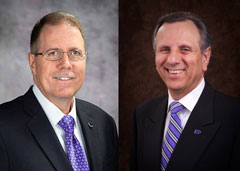August 15, 2018
Strategic Enrollment Management: Our Path Forward
Submitted by Charles Taber and Pat Bosco

Dear Colleagues,
Last January, our university began a comprehensive effort to rethink our enrollment strategies and develop an effective foundation to grow enrollment while also promoting student success now and in the future. In partnership with the Huron Consulting Group and with many of you across our K-State community, the Strategic Enrollment Management, or SEM, Steering Committee focused on understanding current enrollment practices and reimagining directions for recruitment, financial aid, and student retention and success. They shared some key findings and recommendations with the university community at the end spring semester. We are pleased to share that the university's first strategic enrollment management plan was completed over the summer and we have begun moving forward with implementation.
The Kansas State University Strategic Enrollment Management (SEM) Plan: A Path Forward (PDF) is based on primary market research, an intensive analysis of undergraduate, graduate, global, and international student enrollment data, interviews with more than 300 stakeholders across campus — including students, faculty, staff and administrators — and multiple Steering Committee work sessions with our Huron partners.
The plan includes seven key themes with associated observations, goals, and actionable, prioritized strategies that are essential to boosting enrollment and student success. Those themes are Data, Technology, and Systems; Financial Sustainability; Marketing and Communications; Undergraduate Recruitment; Retention and Student Success; Global Campus; and Graduate School. You can find a quick PDF reference guide to the themes, key observations, and goals that will drive the direction of our work on the website.
The plan outlines several enrollment goals:
- Regain and stabilize our in-state freshmen enrollment numbers by growing by 2 percent annually.
- Regain, stabilize, and grow our out-of-state freshmen population from 17 percent to 20 percent of the freshmen class in five years.
- Regain stabilize, and grow our transfer cohort back above 1,000 students by 2023 (4 percent annually).
- Expand our K-State 2025 focus on retention and graduation rates by confirming achievable retention and four-year and six-year graduation rates, comprehensively and by student segment, to meet and exceed peer averages.
The SEM plan, while heavily focused on undergraduate students as the segment where we can have the most immediate impact, also calls for additional work to:
- Assess the capacity for growth in Global Campus programs.
- Define a graduate enrollment strategy collaboratively with the colleges.
- Develop a long-term strategy to grow international student enrollment and increase retention rates.
Implementing the plan requires a targeted, phased, data-driven approach. To be successful, it is clear that we need a more student-centered approach to enrollment management — moving to an institutionwide rather than siloed, unit-specific approach to serving students throughout their K-State experience. Enrollment management is not just about seating a class but also graduating a class, and we must be intentional in our enrollment practices to do both. We need to boost enrollment while also increasing net tuition revenue. Effective and efficient use of scarce financial resources will be critical as we recruit and support students.
Initial plan implementation is underway. Seven preliminary task forces were identified in the plan to begin addressing key activities that will allow K-State to first recover enrollments and improve student success outcomes over the next five years. These task forces report to the SEM Steering Committee, which will evolve to the SEM Governance Council by early fall.
The first two task forces began work in late June in order to have some impact on the fall 2019 recruiting cycle. The Financial Aid and Scholarship Task Force is co-chaired by Gary Clark, senior associate dean of the College of Engineering and Robert Gamez, director of student financial assistance in the Office of Student Life. The Out-of-State Task Force is co-chaired by Tim de Noble, dean of the College of Architecture, Planning & Design, and Emily Lehning, associate vice president for student life and director of New Student Services. The remaining five task forces will be established over the next six weeks. You can read more about the task forces on the SEM website.
The university also extended the contract with the Huron Consulting Group through October to provide services supporting project management, change management, and advisory support, including business case and data analysis.
The SEM Steering Committee and the task force members have worked tirelessly over the summer and we thank them all for their commitment of time and energy. We also thank the many people — current and prospective students, faculty, staff and administrators — who contributed their work and voices through interviews, focus groups, and surveys to creating the SEM Plan. Now the real work begins.
Enrollment and student success is owned by all of us, not by one person, department, or unit. It will take K-Staters working together to make the goals outlined in the plan a reality. We look forward to doing that work with you.
Sincerely,
Chuck Taber
Provost and Executive Vice President
Pat Bosco
Dean of Students and Vice President for Student Life
